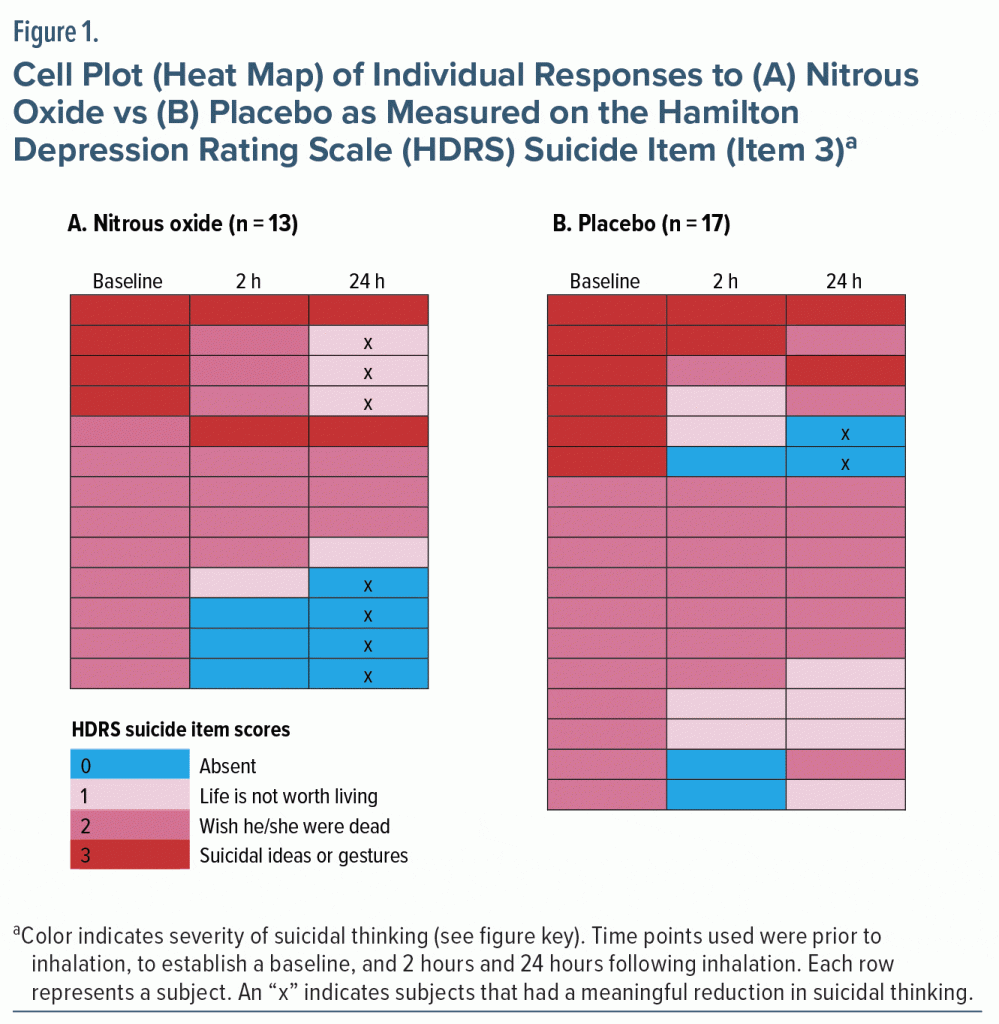Nitrous oxide (N2O) is a colorless, odorless gas commonly used as an anesthetic in dental and obstetric settings.1 Previously, our group demonstrated that N2O has rapid antidepressant effects.2,3 N2O has N-methyl-d-aspartate receptor antagonist properties shared with ketamine; esketamine, an enantiomer, has received FDA approval for rapid reduction in suicidal ideation in major depressive disorder (MDD). In the present analysis, we examined N2O’s ability to reduce suicidal ideation in a pooled secondary analysis of data from 3 crossover trials investigating N2O in subjects with treatment-resistant major depression (TRMD).
Methods
Data were pooled from 3 completed N2O trials at Washington University School of Medicine (ClinicalTrials.gov identifiers: NCT02139540, NCT03283670, and NCT02994433). All studies were double-blind, randomized, placebo-controlled, outpatient crossover trials assessing depression reduction as the primary outcome. Subjects were adults with MDD as determined by the Mini-International Neuropsychiatric Interview.4 All trials enrolled TRMD subjects (at least 3 lifetime adequate dose-duration antidepressant failures, with 1 or more in the current episode). All subjects received separate, 60-minute inhalations of 50% N2O (50% N2O in 50% oxygen) and placebo (air/oxygen mixture). Washout period between conditions was variable across the studies, with inhalations delivered 1–6 weeks apart.
Suicidal ideation (SI) was measured using the standard Hamilton Depression Rating Scale (HDRS)5 suicide item (item 3) at 2 and 24 hours post-inhalation. A clinically meaningful reduction in SI was defined as at least a 2-point score reduction on item 3. Hence, subjects had to start with a score of at least a 2 (“wish he/she were dead or any thoughts of possible death to self”) or a 3 (“suicidal ideas or gestures”) on item 3; ie, those rating a 1 (“feels life is not worth living”) were excluded from the SI reduction analysis. Of note, there were no subjects with a score of 4 (“attempts at suicide”) or any active suicidal intention or planning, as more severe forms of suicidality were excluded from these outpatient trials. A 2-sided Fisher exact test was used to compare the proportion of subjects with clinically meaningful reduction in suicidality across N2O and placebo conditions.
Results
Twenty-four subjects were pooled from the 3 N2O TRMD trials (12/6/6 as per the 3 clinical trials, respectively). A total of 13 subjects in the N2O arm and 17 subjects in the placebo arm scored at least 2 and were included in the analysis.
Using a 2-point decrease in the HDRS suicide item score to define reduction in SI, no trend in SI reduction was observed at the earlier time point (2 hours; P = 1). However, at 24 hours post-inhalation, there was a significant change in SI (N2O vs placebo; P = .019). Figure 1 is a “heat map” showing SI reduction effects of N2O compared to placebo. Of note, 7/13 (54%) of the subjects who received N2O had a meaningful reduction in SI, whereas only 2/17 (12%) in the placebo group showed a similar change. There was a strong relationship between reduction in SI and reduction in total depressive scores for the treatment arm at the 24 hour time mark (Spearman ρ = 0.763).
Discussion
While preliminary, this post hoc analysis of 3 crossover trials demonstrated that N2O, as compared to placebo, reduced SI in a TRMD sample. Similar to ketamine, this SI reduction occurred within 24 hours of exposure.6,7 These findings suggest that N2O may have rapid antisuicidal effects in depressed subjects. Further post hoc analyses demonstrated that the reduction in SI was strongly linked to reduction in depression; further study is needed to elucidate the persistence of the SI and MDD symptom reduction association.
There are several limitations to this secondary analysis: (1) a small sample size; (2) stability of SI prior to study inclusion and randomization is not known; (3) possible carryover effects, as existing N2O studies suggest that antidepressant effects persist at least 2 weeks; and (4) all subjects had TRMD, limiting generalizations to non-resistant depressed populations. Despite the limitations, these findings are promising, and additional study of the potential antisuicidal ideation effects of N2O is warranted.
Article Information
Published Online: August 16, 2023. https://doi.org/10.4088/JCP.22br14725
© 2023 Physicians Postgraduate Press, Inc.
J Clin Psychiatry 2023;84(5):22br14725
Submitted: November 10, 2022; accepted April 17, 2023.
To Cite: de Leon VC, Kumar A, Nagele P, et al. Nitrous oxide reduced suicidal ideation in treatment-resistant major depression in exploratory analysis. J Clin Psychiatry. 2023;84(5):22br14725.
Author Affiliations: Department of Psychiatry, Washington University School of Medicine in St Louis, Missouri (de Leon, Gott, Janski); Bristol Myers Squibb, Lawrenceville, New Jersey (Kumar); Department of Anesthesia and Critical Care, University of Chicago Medical Center, Illinois (Nagele); Department of Anesthesiology and Department of Psychiatry, Washington University School of Medicine in St Louis, Missouri (Palanca); Department of Psychiatry, Washington University School of Medicine in St Louis and Taylor Family Institute for Innovative Psychiatric Research, Washington University School of Medicine in St Louis, Missouri (Zorumski, Conway).
Corresponding Author: Victoria C. de Leon, MD, 660 South Euclid Ave, MSC 8134-0017-04, St Louis, MO 63110 ([email protected]).
Relevant Financial Relationships: Drs de Leon, Kumar, and Janski and Ms Gott have no relevant financial relationships. Although Dr Kumar is affiliated with Bristol Myers Squibb; the company is in no way involved with this work, and Dr Kumar contributed to the work in his individual capacity. Dr Nagele has filed for intellectual property regarding nitrous oxide in major depression (“Compositions and methods for treating depressive disorders”; US20170071975A1). Dr Palanca has a patent pending on control of anesthetic state modulation and an agreement with Elemind on the use of non-pharmacologic potentiation of EEG slow waves. Dr Zorumski is on the Scientific Advisory Board of Sage Therapeutics and has equity in the company. Sage Therapeutics was not involved in this work. Dr Conway is on the Sage Therapeutics Advisory Board and has been a consultant for LivaNova, PLC.
Funding/Support: This work has no direct funding sources. Data used in this secondary analysis came from trials with the ClinicalTrials.gov identifiers NCT02139540, NCT03283670, and NCT02994433. These trials were supported by the Departments of Anesthesiology and Psychiatry and the Taylor Family Institute for Innovative Psychiatric Research at Washington University School of Medicine, St. Louis, Missouri; NARSAD Independent Investigator Award from the Brain and Behavior Research Foundation; and National Institute of Mental Health (NIMH). Dr de Leon is supported by Washington University Institute of Clinical and Translational Sciences, UL1 TR002345 and sub-award TL1 TR002344. Dr Nagele is receiving funding from NIMH, American Foundation for Suicide Prevention, and Brain and Behavior Research Foundation. Dr Palanca is supported by the Washington University Center for Perioperative Mental Health grant number P50 MH122351 from NIMH and NIMH grant U01MH128483. Dr Zorumski receives support from MH122379 and the Taylor Family Institute for Innovative Psychiatric Research. Dr Conway is supported by the American Foundation for Suicide Prevention, Barnes Hospital Foundation, Taylor Family Institute for Innovative Psychiatric Research, August Busch IV Foundation, and research funding through Washington University from LivaNova, PLC, and is the lead investigator of the RECOVER Trial.
Previous Presentations: Presented at Translational Science 2023, Washington, DC, April 18–20, 2023; 2023 SOBP Annual Meeting, San Diego, California, April 27–29, 2023; and 2023 IASR/AFSP International Summit on Suicide Research, Barcelona, Spain, October 15–18, 2023.
ORCID: Victoria C. de Leon: https://orcid.org/0000-0002-5811-2086; Peter Nagele: https://orcid.org/0000-0001-8369-3858; Ben J. Palanca: https://orcid.org/0000-0001-7535-5701; Charles F. Zorumski: https://orcid.org/0000-0002-9704-5154; Charles R. Conway: https://orcid.org/0000-0001-6849-9416
References (7)

- Nagele P, Zorumski CF, Conway C. Exploring nitrous oxide as treatment of mood disorders: basic concepts. J Clin Psychopharmacol. 2018;38(2):144–148. PubMed CrossRef
- Nagele P, Duma A, Kopec M, et al. Nitrous oxide for treatment-resistant major depression: a proof-of-concept trial. Biol Psychiatry. 2015;78(1):10–18. PubMed CrossRef
- Nagele P, Palanca BJ, Gott B, et al. A phase 2 trial of inhaled nitrous oxide for treatment-resistant major depression. Sci Transl Med. 2021;13(597):eabe1376. PubMed CrossRef
- Sheehan DV, Lecrubier Y, Sheehan KH, et al. The Mini-International Neuropsychiatric Interview (M.I.N.I.): the development and validation of a structured diagnostic psychiatric interview for DSM-IV and ICD-10. J Clin Psychiatry. 1998;59(suppl 20):22–33, quiz 34–57. PubMed
- Hamilton M. A rating scale for depression. J Neurol Neurosurg Psychiatry. 1960;23(1):56–62. PubMed CrossRef
- Grunebaum MF, Galfalvy HC, Choo TH, et al. Ketamine for rapid reduction of suicidal thoughts in major depression: a midazolam-controlled randomized clinical trial. Am J Psychiatry. 2018;175(4):327–335. PubMed CrossRef
- Wilkinson ST, Ballard ED, Bloch MH, et al. The effect of a single dose of intravenous ketamine on suicidal ideation: a systematic review and individual participant data meta-analysis. Am J Psychiatry. 2018;175(2):150–158. PubMed CrossRef
Save
Cite
Advertisement
GAM ID: sidebar-top





